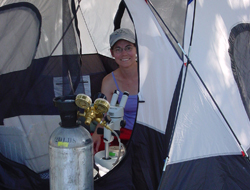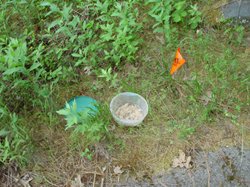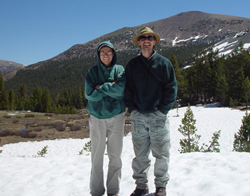|
Melanie Frazier, a recently graduated Biology Ph.D. student and ARCS Fellow, has always been interested in the natural world and how things work. A course at Arizona State University, where she received her bachelor’s and master’s degrees, sparked Mel’s curiosity in insect biology. Insects are a remarkably diverse and abundant group of organisms. They have numerous ways of eating, mating, and avoiding predators, and countless ecological roles. They are adapted to just about every environment on the planet.
Mel, who studied in Ray Huey’s lab, is especially interested in insect stress physiology. Altitudinal gradients offer a suite of intriguing environmental conditions for studying stress physiology. Tightly correlated with a rise in elevation are steady declines in air density and average temperature. Consequently, there are a number of physiological stresses that coincide with increases in altitude. Changes in plant and animal morphology and/or physiology along an altitudinal gradient often reflect adaptation to the changing environmental conditions.
|
The subject of Mel’s research is the fruit fly, Drosophila. Mel used Drosophila to study the effects of air density and temperature on physiology and behavior. Her research has shown that at low temperature and low air density, conditions typical of high altitude environments, hypoxia, or oxygen deficiency, is not a critical problem for Drosophila. But as temperature rises and air density stays low, hypoxia becomes an increasingly severe problem. The high temperature-low oxygen combination causes a significant lag in development time and results in stunted adult flies.
Mel’s research also revealed that flight performance suffers under low air density and low temperature. But as temperature and air density increase, flight performance improves significantly. Interestingly, there is a greater proportion of flightless insect species at high elevation. Mel’s findings hint at an evolutionary explanation for this: It may be that the low air density and low temperature at high altitudes make flying so metabolically expensive that flightless insects are actually better adapted to high elevation conditions.
These findings are interesting to consider with respect to predictions about climate change. If average temperatures increase, flight conditions at high elevation would theoretically become more favorable. But higher temperatures may also mean a greater risk of hypoxia. What affect these changes would have on the composition of high elevation insect communities is difficult to predict. But changes in insect community composition would surely lead to changes in plant community composition, as well.
|
|
In the future, Mel is interested in researching the connection between insect physiology and behavior and plants. Most plants rely on insects for reproduction and many insects rely on plants for food and shelter. Consequently, their evolution is tightly correlated. Insects adapt to novel traits in plants and vice versa, all in an effort to maximize their respective reproductive output. For example, plants pollinated by flightless insects often have their flowers at ground level so they are easily accessible.
Widespread changes in climate could disrupt this relationship, which has developed over millions of years. If average temperatures rise, species at sea level or mid-elevation theoretically could move up a mountain to remain in their optimum temperature range. But at the top of a mountain, there is no moving up to cooler temperatures; so, mountaintop species are considered particularly vulnerable to extinction. In a tight-knit plant-insect relationship, whether a species goes extinct or not may not depend entirely on how quickly it adapts to warmer temperatures, but whether the species it is reliant upon can also make the shift. Research aimed at uncovering plant-insect associations will provide data with which to make predictions about the consequences of a changing climate, and, ideally, information to design effective conservation plans where necessary.
This past July Mel finished graduate school and in August she led a group of 20 UW undergraduates to China to study plant-insect interactions across an altitudinal gradient leading up to the Tibetan Plateau. Her co-instructor on the trip, Michael Dillon, is a post-doctoral researcher in Ray Huey’s lab and has studied bumblebees along this transect since 2001. The students were each responsible for conducting an independent project designed to uncover the effects of altitude on interactions between plants and insects.





